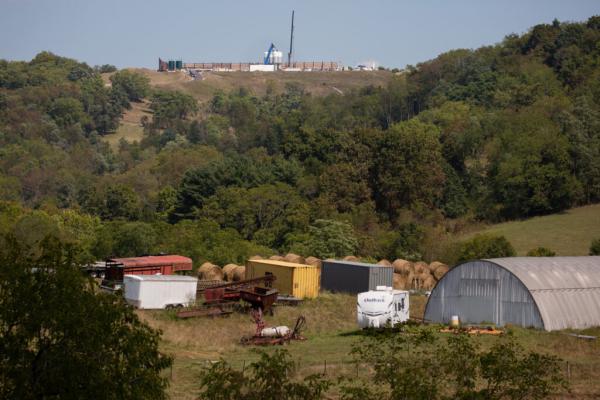Turning undersea cables into a global monitoring system for seismic and environmental hazards
Nov 7, 2025, 10:40 pm By NULLEU researchers are exploring how undersea communication cables can double-up as environmental and…Climate policy strengthens globally, despite unprecedented contestation in the US and Europe
Nov 7, 2025, 10:00 pm By NULLAs countries meet at COP30 in the Amazon, a new Oxford University study gives the most detailed view…Researcher sees 'a lot of backsliding on climate commitments' since 2015 Paris conference
Nov 7, 2025, 8:50 pm By NULLThis year marks the 10th anniversary of the Paris Agreement. At that time, the countries of the…Defunct Pennsylvania oil and gas wells may leak methane and metals into water
Nov 7, 2025, 6:20 pm By NULLIn the dense forests of northwestern Pennsylvania, hundreds of thousands of retired oil and gas…Earth 'can no longer sustain' intensive fossil fuel use, Lula tells COP30
Nov 7, 2025, 2:49 pm By NULLBrazil's President Luiz Inacio Lula da Silva on Friday said Earth cannot sustain humanity's…Why measuring land-use carbon emissions is so challenging—and how to fix it
Nov 7, 2025, 1:00 pm By NULLA team led by LMU researchers shows why CO₂ fluxes from land use are so difficult to…Enhancing ocean wind observation accuracy: New rain correction approach for FY-3E WindRAD
Nov 7, 2025, 12:58 pm By NULLSatellite scatterometers play a crucial role in monitoring ocean surface winds, with their accuracy…Biofuel pledge at climate summit highlights India's ethanol blending debate
Nov 7, 2025, 10:17 am By NULLIndia's push to blend ethanol with gasoline shows the benefits and challenges of the sustainable…New report sheds light on how UN SDG 11 is shaping urban planning systems around the globe
Nov 7, 2025, 10:12 am By NULLThe global planning community must move "from awareness to action" if the UN's goal of sustainable…Cracks in Antarctic 'Doomsday Glacier' ice shelf trigger accelerated destabilization
Nov 7, 2025, 9:42 am By NULLThwaites Glacier in West Antarctica—often called the "Doomsday Glacier"—is one of the…Deadly Typhoon Kalmaegi ravages Vietnam, Philippines
Nov 7, 2025, 7:16 am By NULLTyphoon Kalmaegi churned across Vietnam Friday, claiming five more lives after its devastating…As global climate action threatens to stall, can Australia step up at COP30 in Brazil?
Nov 7, 2025, 6:37 am By NULLTen years on from the landmark Paris Agreement, countries have taken big strides in limiting…Antarctic ice melt triggers further melting: Evidence for cascading feedbacks 9,000 years ago
Nov 7, 2025, 5:00 am By NULLA study has revealed that the substantial retreat of the East Antarctic Ice Sheet (EAIS)…Leaders turn up the heat on fossil fuels at Amazon climate summit
Nov 7, 2025, 4:50 am By NULLWorld leaders will meet for a second day of climate talks in the Brazilian Amazon on Friday after…Big leap in quest to get to bottom of climate ice mystery
Nov 7, 2025, 4:46 am By NULLStanislav Kutuzov felt the drillhead he was controlling smash into the rock more than 100 meters…Operation Cloudburst: Dutch train for 'water bomb' floods
Nov 7, 2025, 4:42 am By NULLA twin-prop Chinook helicopter shatters the calm of the Dutch countryside, hovering just meters from…Hurricane? Cyclone? Typhoon? Here's the difference
Nov 7, 2025, 4:29 am By NULLTyphoon Kalmaegi has killed at least 114 people in the Philippines with even more missing and then…What 50 years of buried data tell us about Canada's mining oversight
Nov 6, 2025, 9:40 pm By NULLThe global demand for critical minerals is surging. Driven by the clean-energy transition, digital…Mapping a new frontier with AI-integrated geographic information systems
Nov 6, 2025, 4:06 pm By NULLOver the past 50 years, geographers have embraced each new technological shift in geographic…New deep learning model enhances roadside air pollutant forecasting accuracy
Nov 6, 2025, 3:17 pm By NULLA research team led by Prof. Li Xiangxian from the Anhui Institute of Optics and Fine Mechanics, the…
Welcome to EcoTopical Your daily eco-friendly green news aggregator.
Leaf through planet Earths environmental headlines in one convenient place. Read, share and discover the latest on ecology, science and green living from the web's most popular sites.
Leaf through planet Earths environmental headlines in one convenient place. Read, share and discover the latest on ecology, science and green living from the web's most popular sites.





